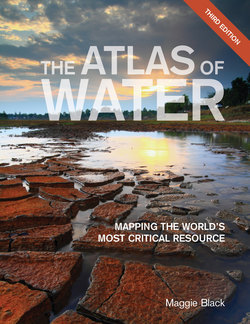Читать книгу The Atlas of Water - Maggie Black - Страница 27
На сайте Литреса книга снята с продажи.
ОглавлениеCompetition and Conflict
Nile Basin
As populations grow and more water is extracted, competition over the exploitation of rivers, lakes and aquifers increases. Where major water sources cross national boundaries, this can lead to political tension. Many countries share rivers, and some depend heavily on water flowing in from elsewhere. When rivers are dammed or flows diverted in such a way as to benefit one population and deprive another, the potential for conflict increases sharply. The discharge of pollutants can also pit downstream against upstream inhabitants. These pressures have led to talk of “water wars”. So far, no war has been explicitly fought between nations over water, although occasional military, terrorist or activist strikes have been undertaken to destroy dams, cut off supplies or capture sites as part of a populist or other type of campaign. Sabre-rattling over some upstream hydraulic projects has also become increasingly noisy. Water supplies feature strongly in some major political disputes, including that between Israel–Palestine. In Central Asia, confrontation has developed between six republics over what used to be a centralized dam and irrigation network in the days of the Soviet Union. In India, a dry year can lead to inter-state violence over ungenerous water releases by upstream states. Competition between user groups with conflicting interests is not uncommon. Industrial users and farmers may dispute use of scarce resources, or companies with a commercial interest in water supplies may find themselves at loggerheads with local people who rely on the same supply for cultivating their basic crop. Water disputes need to be solved at the basin-wide level, whether this is within one country but between states (as in India); or international, as in the case of the Nile and Indus. An increasing number of tribunals and river basin organizations have come into existence for this purpose.
The Nile is shared by Burundi, DR Congo, Egypt, Ethiopia, Kenya, Rwanda, South Sudan, Sudan, Tanzania and Uganda. Because it receives no run-off for 40% of its length, its flow is relatively small. Under a colonial-era agreement, downstream and dependent Egypt and Sudan were entitled to command of the Nile, causing upstream resentment. A Nile Basin Initiative is now trying to integrate the needs of all basin countries.
Bolivia–Chile
The waters of the Silala spring, Bolivia, flow through a canal westwards into Chile, where they are vital to the processing of copper in the Atacama desert. A disagreement over the natural course of this water prior to the construction of the canal in 1908 is part of a long-running territorial dispute. Bolivia claims that the water in the Silala Aquifer is its national property, the artificial canal is not governed by international water law, and Chile should pay Bolivia around $15,000 a day for the water. A draft bilateral agreement was rejected by Bolivia in 2010.
Q 4 Rising Demand; 5 Dwindling Supply
30
